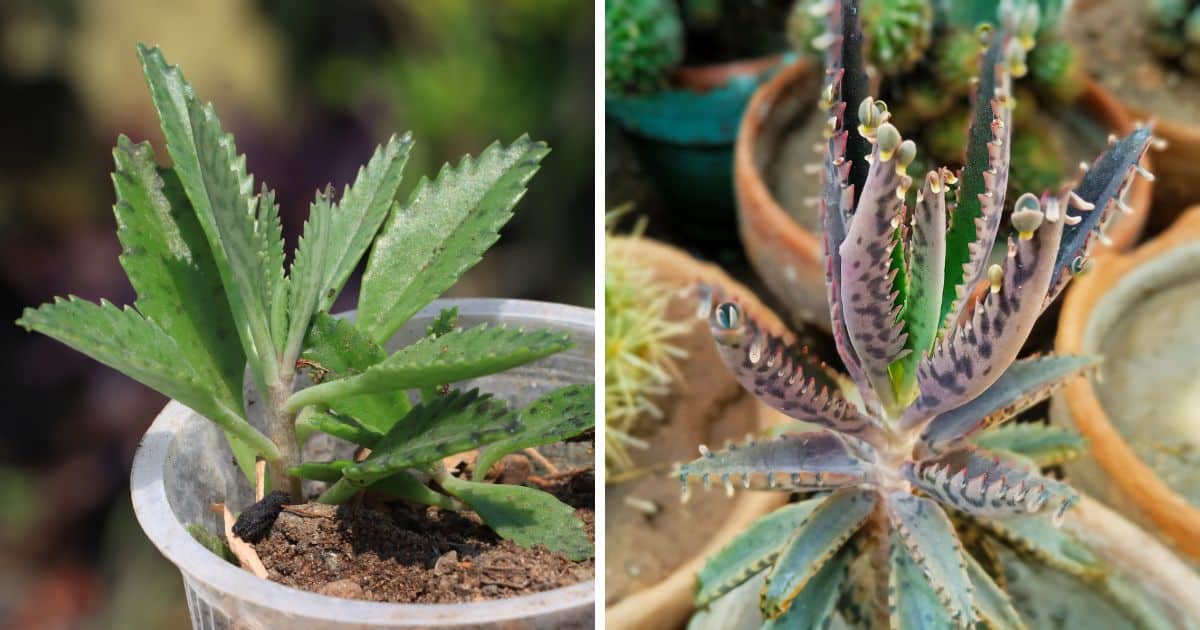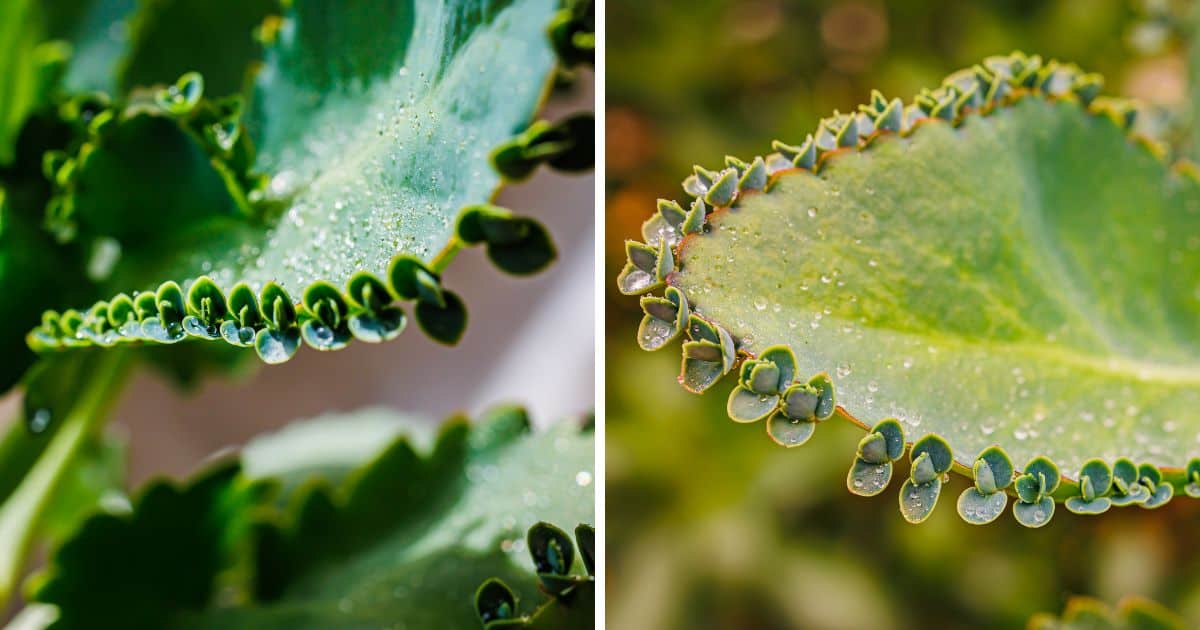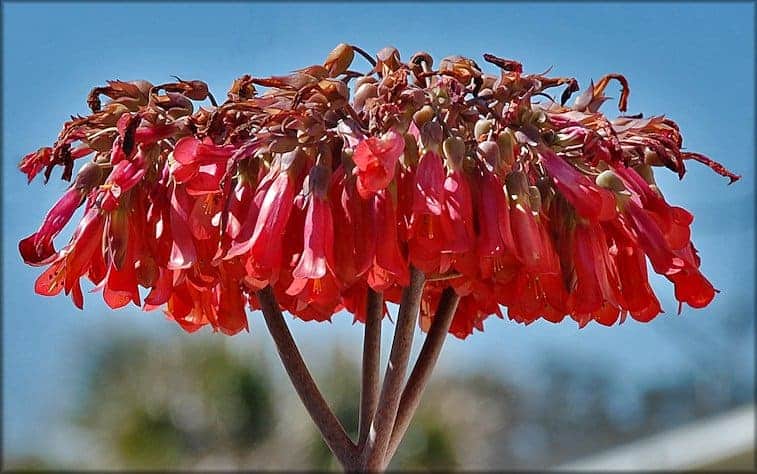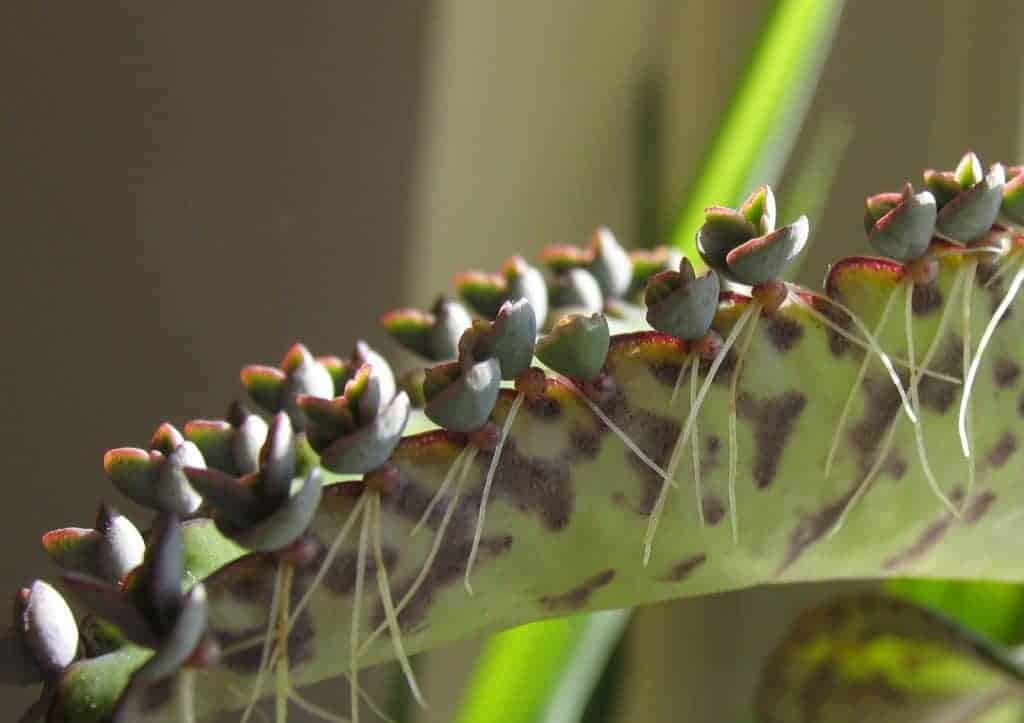These are two popular plants that get talked about all the time! However, both species have tons of common names. Which Mother is which? What's the difference? Where can I get them??

Read on to find out everything you need to know about these two kool Kalanchoe.
Jump to:
Which plant is which?
People often confuse these plants, either because they don't know to use the correct name, or because they don't know that they are two different plants! It certainly doesn’t help that each plant has a handful of different nicknames.
That's why we have scientific names.

They are supposed to clear up confusion created by people calling the same plant different names.
Unfortunately, in this instance, the scientific names of these plants are also in flux!
The plants were previously part of the Kalanchoe genus, but have been reorganized into the Bryophyllum genus. Some scientists even consider Bryophyllum to be a section of Kalanchoe, rather than an entirely separate genus. The reason for this confusion is that there is some debate about the results of a recent molecular phylogenetic analysis. That’s science-speak for a DNA test. This causes even more confusion!
Now that you've got an idea of which plant is which, you can read on for some information about the two!
What are the main differences between Mother of Thousands and Millions?
The biggest difference is the shape of their leaves.
Thousands
Mother of Thousands has broad, tear-shaped leaves. You'll notice that they always grow in pairs, each leaf on opposite sides of the stem.
The next pair of leaves rotate 90 degrees, so that the new leaves don't block the sun from the old ones! This alternate leaf pattern is common in plants and helps ensure all the leaves get sunlight.
If you look at the edges of the leaves, you'll see they have little ridges. That is where the baby plantlets form! These plantlets, or buds, grow all along the edge of the leaf. A happy, healthy leaf will have a full complement of babies around the edge of it.
Leaves also rush to grow babies if they are damaged or think they're about to die.
Millions
Mother of Millions, on the other hand, has very narrow leaves. You'll notice that it has 4 leaves that all grow from the same place on the stem (the node).
These don't alternate like the Mother of Thousands. The plantlets on these leaves only grow at the end of the leaf, near the tip. Usually, there are between 2-4 babies on each leaf.
No products found.
Mother of Millions is considered a noxious weed in parts of Australia and Africa because of its rapid growth and spreading, in even the most adverse conditions.
The final difference in these two Mothers is the behaviors of their growth. Mother of Thousands usually has a central, single stalk that grows up towards the sunlight.
It will often fall over due to the weight of its heavy leaves, and continue growing. Mother of Millions often has several stalks rising from the same plant. While they primarily grow upwards, they can form bush-like patches.
What are the similarities?
Since they are in the same genus, they are very closely related. They are both from Madagascar, and as such, enjoy the same treatment as most succulents in regards to the sun, water, and soil.
They thrive in bright direct sunlight, though they can also do pretty well in indirect light. These two Mothers appreciate the same watering schedule that most succulents do (infrequent, heavy waterings). In the soil department, they want loose, fast-draining soil.
Be sure that the container you plant them in also provides appropriate drainage. Soil that drains quickly won’t do you any good if that water has nowhere to go.
Despite all their preferences, these plants seem to thrive on neglect. I've spotted them growing in sidewalk cracks in Charleston, South Carolina. They've sprouted up in a dark corner after falling from their mother. As with most succulents, they are survivors that are capable of growing in surprisingly harsh conditions.

I've seen them thrive in places that are perpetually wet, a feat unheard of in the succulent realm. Not only do they handle wet climates with ease, but they’re capable of surviving mild frost as well. Both species are prolific growers. Those little plantlets can and will drop off and grow just about anywhere!
It follows that Mother of Thousands and Mother of Millions are considered by some to be weeds. While "weed" is a subjective term for a plant people don't want around, these two plants sure do act like weeds.
Their method of propagation is extremely efficient, so much so that it has a tendency to overtake other plants and crowd them out. The plantlets that form on their leaves are literally miniature plants.
They are already growing and photosynthesizing while attached to their mother. Most even produce roots in addition to their leaves. By the time they hit the ground, they're already a plant!
That's a huge advantage on those lame, regular plants that have to grow from seeds. In general, succulents tend to be slow growers, especially when grown from seeds. This is why most succulent gardeners choose to propagate their plants from cuttings or offsets. The Mothers have realized this advantage and chosen to go with the more efficient method of propagation as well.
They do produce seeds, although you'll probably never see them. The seeds are usually brown and are quite tiny at less than one millimeter long. The seeds are capable of surviving for years before sprouting.
Their flowers are quite pretty, often orange or red, and sprout from a central stalk. The flowers are pendular, which differentiate these plants from other members of the Kalanchoe genus.
The reason that the Mother plants don't flower too often though. It's easier and more efficient to propagate via buds!
Both Mother of Thousands and Mother of Millions are considered to be noxious weeds is that they are poisonous, unfortunately. The specific toxin in these plants is bufadienolide cardiac clycosides, which causes cardiac arrest in those that consume enough of it. The toxin is present not only in the milky sap within the stem, but the flowers, in particular, are highly toxic. Hybrids of these plants are also considered to be poisonous.
In fact, Australian cattle frequently die from grazing on Mother of Millions, so the plant has a very bad reputation there. In 1997, a herd of 125 cattle in New South Wales died after grazing in an area where Mother of Millions had taken over. They are aesthetic house plants elsewhere, but you have to be vigilant that they do not spread to other pots or outside your home.
For this reason, we recommend planting your Mothers in containers, rather than in the ground if your climate allows you to grow succulents outdoors. Plant pests such as these are more easily contained when they’re planted in pots, especially if you keep them far enough away from your other pots to prevent them from spreading.
Caring for Mother of Thousands and Mother of Millions is less about helping them grow and more about keeping them from spreading. These plants will take care of their own survival, you just have to make sure you keep them contained.
Where can I get these plants?
Just about anywhere. If you spot one in a public place, you could snag a couple of plantlets off a leaf tip. Be sure to ask the owner of the plant for permission, though All dedicated succulent owners have come across the Mother of Thousands and Mother of Millions.
If they kept one, they certainly have plenty of babies or saplings to give away. Check succulent Facebook pages that swap plants and succulents in your area. If you have a cactus and succulent society or club in your area, you might ask members if they have any available or know where you might be able to find them. These types of groups are a great resource for succulent information, so they’re usually worth joining, even if they can’t help you find the specific plant you’re looking for.
They are easy to grow succulents, and much loved by beginners.
You can also buy them online, though they are sometimes hard to find because they are considered weeds in some places. Online retailers such as Mountain Crest Gardens often carries both Mother of Millions and Mother of Thousands.


Check also at your local home improvement stores in the succulent section, as these show up from time to time, although always mislabeled.
Some local garden centers or nurseries may also have them, or at least know where you might be able to find them. Don’t be afraid to ask!
Is there any other information you want to know on Mother of Thousands or Mother of Millions? Tell us below in the comments!
You Might Also Like:




joanne Schuler
I have a different looking plant with thick leaves that are opposite, with leaves shaped like Mother of thousands but not cupped, lighter in color and on the blue/green side. Has a new plant coming off the end of two of the leaves. I am assuming it is also a different kind of Mother of thousands. Can you tell from my discription? I also has grayed purple elongated spot.
Payal
Very informative.
Mary Jackson
Not an answer but another question.
I purchased a Mother of Thousands from a nursery 3 weeks ago. It was very healthy looking but they had it in a dark room to keep it from "interfering" with the other plants. It did not have any babies.
I brought it home and watered it and left it on my covered patio,
To date it has not started producing babies.
Am I doing something wrong?
Thanks for any information
Patrick Grubbs
In my experience, they don't all produce babies at the same time. Some do it while they are babies themselves! Others have gotten more than a foot tall before they even thought about it.
Don't worry too much. It'll happen eventually, then never stop. Try stressing it out if you want to induce propagation quickly. More sun, less water, etc.
Maria Oquendo
Plenty of some light will encourage the plant to produce babies. I have hundreds of them and the babies keep coming. My main plant is over a year old and just started loosing leaves but I have many more growing quickly in the sun.
Woody Little
I have several of these in large pots mixed with silver dollar plants. I didn't even realize they were both native to Madagascar! I've seen these plants in the 'wild' in Florida, and suspect they were on someone's deck and they spread. I live in Iowa, so mine overwinter inside, they do NOT like anything below freezing.
Mine develops babies in the heat of the summer and then stop again once the temps dip into the high 40s at night. they do not usually have any on their leaves during the winter, though they are in decent sunlight.
One question I do have about these gals - why do the top 3 or 4 sets of leaves curl up, sometimes so much they loop back to the stem?
Patrick Grubbs
Thanks for sharing your experiences with them!
I'm not sure exactly why they loop - but they totally do. I've noticed that when they lack light, the leaves point up and out, like they're reaching for it. When they have plenty, the leaves curl down and become quite dense, especially on the lower parts of the stem.
Berta Brush
They are natural catapults to spread in nature
Dennis Feldman
How long does the plant flower, and how long does the flower last? Do all of the plants flower?
Patrick Grubbs
Yes, all Kalanchoe plants will flower. These two don't do it very often, and the flowers only last a couple weeks.
Maybe try looking for a Kalanchoe blossifeldania - they flower all the time and are commonly sold at grocery stores.
Berta Brush
They flower in their second season end of November flowers last for months just fading in color Purple to orangish depending how bad the winter is going to be
Marlys Heffron
Is it recommended to 'thin out' the pots due to the constant addition of other 'babies'? If they are so toxic, what does one do when you have an abundance of 'babies' and want to be rid of the surplus? If the plant is in a pot outside of a private yard, and the 'babies' drop outside of the pot, will they be harmful to any 'critter' if they happen to eat one or must they consume many? I just purchased a plant tagged an 'alligator plant' at a plant sale and do not know anything about it. But from reading about it on this site, not sure it was a good purchase. I bought it for a friend who has 'two black thumbs' and figured a succulent would be good for her here in Texas. What do you suggest?
Patrick Grubbs
You don't need to thin out the pot, they'll happily grow in crowded settings. In order to get rid of the excess, I'd recommend burning them or shredding them thoroughly before tossing in the garbage.
It's certainly poisonous, but not aggressively so. A dog that manages to eat a small plantlet will probably just get sick. If they eat a full adult plant, they absolutely need to see a vet because their life is in danger.
It's a great, easy plant for novice gardeners, but I'd recommend keeping it inside to minimize spread and avoid potential poisonings.
Lester
Gosh.. I have a mother of trillion!...it is a crazy plant...it constantly dropping babies...at first was amused by the amount and started placing little containers around the mothership plant... I throw away hundreds a week.. anyone need babies, offspring let me know how much you want FREE!.. I have never had a plant I'm scared of until this one.
Patrick Grubbs
It's true that they're toxic, that they'll drop the babies everywhere, and that if outside they absolutely can and will spread. Most of Texas is a great environment for them, too, so the danger is particularly real. If critters eat them, they may die.
That being said, I don't think it's necessarily a bad purchase. It is a very easy beginner plant. You should suggest that they keep it indoors. If outside is necessary, try to put it an area protected from wind that has concrete floor so they can't spread and propagate easily.
Lou
There is a lot of information out there that is saying the Mother of Thousands plant can be used to treat (and possibly cure) cancer. There are even some sites selling the plant with directions on how to blend up the leaves into a drink. This seems quite dangerous and irresponsible if it is indeed toxic. Have you heard anything on this?
Patrick Grubbs
I haven't heard about it, but I'm not surprised. Cancer is a horrible disease and it makes people desperate enough to entertain any possible cure. There are many confirmed cases of livestock and pets dying to Kalanchoe, and (I'm certain) zero confirmed cases of people curing their cancer with the plant.
Don't trust random internet people's medical advice. Only take instructions from a real-life doctor.
teng montalbo
I have a couple of Mother of Thousands, and I have the following questions:
1) You said that the sap is quite toxic for pets and kids, in order for it to be harmful, must the sap be taken in or eaten or it just by touching the sap, skin rashes would appear ?
2) Can it thrive inside my house?
3) At what age, can the flowers appear?
Patrick Grubbs
1. It's possible to get a rash from the sap, but if you wash it off (or at least wipe thoroughly) you won't have problems.
2. Absolutely. All of mine are indoors. Keep them in a window with good light though, or they'll get leggy.
3. Once they reach maturity after a year or two flowers can appear. I haven't had much luck getting them to flower, though, so I don't have much advice to give there.
Melanie Wilder
I would like to see a picture of the poison leaves you are talking about.
Patrick Grubbs
All Kalanchoe plants are poisonous, so any leaf that belongs to them would be too.
Melanie Wilder
Please send me picture of poisonous succulent leaf you are referring to.
Patricia Johnson
All the leaves fell off my Mother of Millions, leaving me with two bare trunks. Should I throw it away?
Patrick Grubbs
It depends why the leaves fell off and whether or not that's an indicator of the plant's overall death. I'd keep it around for a couple weeks to see if anything shows up - otherwise, cut your losses.
Suzanne Murphy
I have a "thousand" mother. It has grown quite fast fro two on a little stalk to a taller one with several leaves. I've tried to water it no more often than every 10 days- notably the 10th, 20th and 30th.
After watering it on the 30th I noticed it started to fall over and the leaves don't feel as strong. Do I need to prune it? It has not flowered yet.
Patrick Grubbs
It sounds like it may be etiolated. Does it get a lot of light? Kalanchoe prefer bright, direct light. If the leaves are soft, it's either because they're over or under watered. That probably depends on your soil as much as your watering habits.
You can prune Kalanchoe whenever. They grow back so fast it doesn't really matter.
Astrid
Hi. I have a mother of thousand, i keep it in the window, it keeps growing and produceing leafs and lot of plantlets. But my issue is that it keeps droping leaves from the bottom up. So the lowest half of it doesnt have any leaves left. Is this normal?
I live in denmark, so quite far from its natural eviroment could be part of it.
Patrick Grubbs
Hmm, mine drops leaves occasionally, but not often. Maybe you're watering it a little too much? You can always just cut off the top and stick it back in the dirt, that'll slow the growth for a little while and the leaves will be near the ground again
Margarita Siboldi
Great article and follow up to readers' questions. I found all the answers I needed. Thank you!
Patrick Grubbs
Glad to have helped!
Bill Wilson
Just an observation about the ease of this plant spreading. The baby plants that drop can be spread by water. We have 1 MoM in a low lying yard that can flood 1-2 in. in a heavy rain. We have found babies growing 50 ft away across the yard.
Patrick Grubbs
Can't say I'm surprised haha. That's an interesting observation, thanks for sharing!
hugh mathews
hi , i have grown two mot,s about four foot high in a pot in a sunny window ,
supported with sticks , no flowers though !
Patrick Grubbs
Yeah, they dont flower all that often in my experience.
Megan
I just realized that I have a mother of thousands. I bought it as a baby and it's just now old enough to be developing pups all over the outside...that's when it clicked that is what I have and I'm so excited!
Patrick Grubbs
Exciting! It's a fun plant to grow 🙂
Joey Ball
Hello,
Is there a way to trim these plants without ruining them. I have one plant that has 2 shoots and it has become very “leggy” I’d like to trim it but I’m afraid I’ll kill the plant.
Thank you!
Patrick Grubbs
Snip away. You can cut these guys anyway you want and they will bounce right back. Don't worry in the slightest.
Jacquelyn
Do you still have your free mother of thousand babies ??? Would love to have some...Let me know...
Angel Rose Voges
I would love some of your babies. Thank you for offering.
Angel Rose